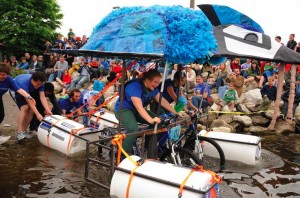 The dozen or so Hopkins students, a few parents, siblings, and assorted others lugged “Twitter-Jay” past brick row houses on Baltimore’s Kenwood Avenue in the early afternoon of May 2. Although spirits were high, the day was getting hot, the enormous blue jay heavy, and everyone—even the 300-pound bird—looked a little weary. After all, they’d been racing for six hours and still had to make it through Patterson Park’s obstacle course and over five miles of Baltimore streets before they’d reach the finish line.
The dozen or so Hopkins students, a few parents, siblings, and assorted others lugged “Twitter-Jay” past brick row houses on Baltimore’s Kenwood Avenue in the early afternoon of May 2. Although spirits were high, the day was getting hot, the enormous blue jay heavy, and everyone—even the 300-pound bird—looked a little weary. After all, they’d been racing for six hours and still had to make it through Patterson Park’s obstacle course and over five miles of Baltimore streets before they’d reach the finish line.
Twitter-Jay and the Recyclists were among 26 entrants in the 11th annual Kinetic Sculpture Race. This test of artistry, engineering, and endurance, sponsored by Baltimore’s American Visionary Art Museum, requires that teams build amphibious, human-powered works of art that are capable of traveling over 15 miles of pavement, through sand and mud traps, and in the Inner Harbor. Twitter-Jay, the Homewood campus’s first entry in the race, was conceived of and built over the course of the academic year by graduate and undergraduate Hopkins students in Engineering and Arts and Sciences.
“Designing and building, finding materials, figuring out all the details—it was a lot more work than I expected,” says Nora Krinitsky ’09, a history major and the team’s organizer. “And we couldn’t have done it without the engineering students’ technical knowledge. This was a great example of what can happen when Hopkins students have the chance to combine their expertise.”
Everything the students built worked exactly as planned. Constructed mainly out of recycled materials—wings made from thousands of blue plastic bags, a bamboo and electrical conduit infrastructure modeled on “buckyballs” (C60 molecules) held together with zip ties, and giant Pepsi barrel pontoons—the blue jay also housed a high-tech communications center that enabled the team to text and “tweet” its followers while providing GPS data and live video feed. The materials the students didn’t scavenge were purchased with funds from a Homewood Arts Innovation Grant and a Creative Use of Technology Grant from the Digital Media Center.
Among their major purchases were two $50 bicycles they had welded to the frame that supported the blue jay. And this, it turns out, was their downfall. As the Recyclists passed the National Aquarium, the bike wheels buckled and Twitter-Jay collapsed. Rather than give up, the group quickly decided to jettison their electronics, paddle wheels, and all other nonessential equipment. Except for the requisite dip in the Inner Harbor (for which they used their required emergency oars), they carried Twitter-Jay the entire way.
As they approached Patterson Park, families and friends gathered on marble stoops to witness the spectacle, shouting words of encouragement as the students trudged by. And Tabor Barrante, the sophomore mechanical engineering major who had led the bird’s art team and designed its infrastructure, waved from her bicycle seat perch.
That evening, at the museum’s closing ceremony, the Hopkins team proudly accepted the Golden Dinosaur Award, the prize given to the first sculpture to break down or have the most memorable failure.
David Hung, the materials science and engineering graduate student responsible for overseeing the sculpture’s balance, flotation, and other critical calculations, had an explanation for what happened: “Hopkins has great engineering. We just didn’t have enough engineers.”




